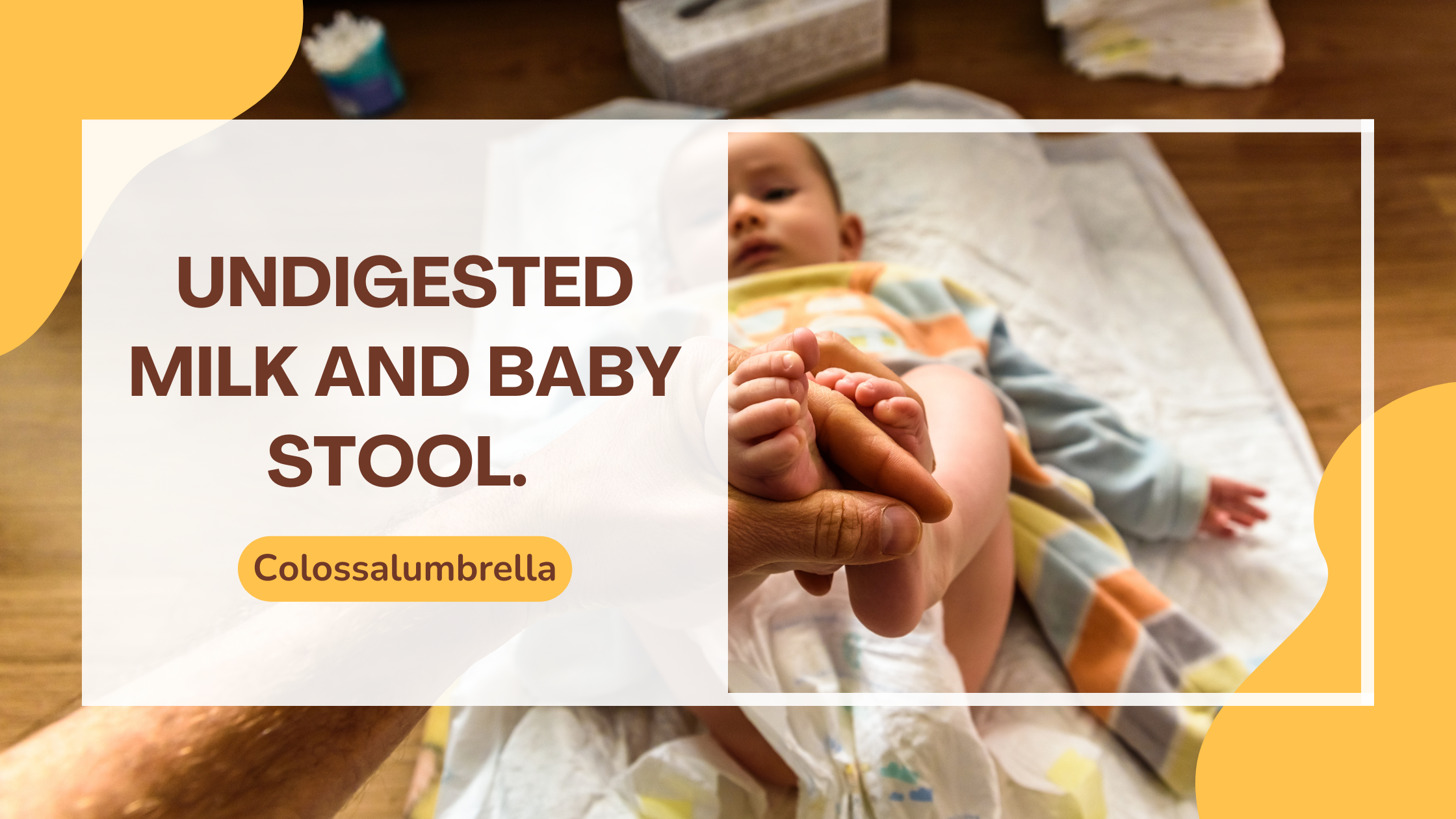Contents
Amidst the sleepless nights and endless diaper changes, there’s one topic that tends to consume the minds of new parents: baby poop. Yes, you heard that right! From color to consistency, parents become fascinated with every little detail of their little one’s bowel movements. And let’s be honest, it’s completely understandable. After all, your baby’s poop can offer valuable insights into their overall health and well-being. One particular phenomenon that often leaves parents scratching their heads is the presence of undigested milk in baby stool.
In this article, we’re going to dive deep into the curious case of undigested milk in baby stool. We’ll explore what it means, why it happens, and whether it’s a cause for worry or just a normal part of the baby digestion process.
Understanding the Digestive System
To comprehend the presence of undigested milk in baby stool, it is crucial to have a basic understanding of the digestive system in infants. The digestive system of a newborn is still developing and maturing, making it less efficient compared to that of older children or adults. The breakdown of complex substances, such as milk, relies on specific enzymes produced by the body. However, in newborns, the production of these enzymes may be insufficient, leading to undigested milk particles in the stool.
Subscribe to my blog for Parenting tips that will make you feel like a pro, and get access to exclusive free Printables that will keep your little ones busy and happy!
Normal Characteristics of Baby Stool
Before diving deeper into undigested milk in baby stool, let’s establish the normal characteristics of baby stool. The frequency and consistency of bowel movements vary among infants, but generally, they should occur regularly. The color of stool can range from yellow to brown, depending on the baby’s diet and age. Texture-wise, normal stool should be soft and resemble a thick paste. As for odor, it’s important to note that baby stool typically has a mildly sweet or sour smell.
Undigested Milk in Baby Stool
When babies consume breast milk or formula, it undergoes digestion in their immature digestive systems. However, sometimes, certain components of the milk may remain undigested, resulting in the presence of white curds or chunks in their stool. This occurrence is fairly normal and can happen in both breastfed and formula-fed babies.
Dr. Cindy Rubin, a board-certified pediatrician and breastfeeding specialist, explains that white cottage cheesy chunks or curds in baby poop are common and can occur in both breastfed and formula-fed babies. She emphasizes that the color and consistency of baby poop can vary greatly and may change frequently.

Causes of Undigested Milk in Baby Stool
The appearance of white chunks in a baby’s poop can be attributed to various factors. Let’s explore some of the common causes:
- Undigested Fat Globules: Breast milk contains fat globules that may pass through the baby’s digestive system without being fully broken down. These undigested fat globules can appear as white curds in the stool.
- Undigested Excess Breast Milk or Formula Protein: Excess breast milk or formula protein can curdle in the baby’s digestive system, leading to the formation of white chunks in the stool.
- Undigested Solid Food: If your baby has started consuming solid food, the white chunks in their poop may be undigested bits of food. Babies’ digestive systems are still developing, and they may have difficulty fully digesting solid foods, resulting in the presence of undigested food particles in their stool.
Symptoms – Undigested Milk in Baby Stool
While the presence of white curds in a baby’s stool is often harmless, certain symptoms may indicate the need for medical attention. It is important to be aware of these symptoms and consult your pediatrician if you notice them. Some of these symptoms include-
- Pale Poop: If your baby’s poop appears pale yellow or gray, it may indicate a potential issue with their liver not producing enough bile. In such cases, medical evaluation is recommended.
- White Poop: Grayish or white poop in babies could be a sign of a blocked liver or a condition called biliary atresia. Although these conditions are rare in newborns, it is crucial to seek emergency medical evaluation if you observe white poop in your baby’s stool.
Understanding Baby Poop Colors
Baby poop can come in various colors, and it can change as they grow and their diet evolves. Here are some common colors of baby poop and their meanings-
- Black Poop: Meconium, the baby’s first poop after birth, is thick and black. It consists of substances the baby ingested while in the womb, such as amniotic fluid and skin cells.
- Yellow Poop: After the first few days, a baby’s poop transitions to a yellowish-green color. This is considered normal for breastfed and formula-fed babies.
- Brown Poop: As babies continue to grow and their digestive systems mature, their poop may become brown in color. This is typically the case for both breastfed and formula-fed babies.
- Orange Poop: When babies start eating solid foods, the color of their poop can change depending on what they consume. Foods like carrots, sweet potatoes, and pumpkin can give the poop an orange hue.
It’s important to note that variations in the color of baby poop are generally normal. However, if you notice any significant changes or have concerns about your baby’s stool color, it is recommended to consult your pediatrician.
Milk Allergy and Undigested Milk in Baby Stool
In some cases, undigested milk in a baby’s stool may be a result of a milk allergy. Cow’s milk allergy is the most common food allergy in infants, affecting up to 3% of babies in developed countries by the age of 1.
A milk allergy occurs when the baby’s immune system overreacts to milk proteins. This can occur with cow’s milk, as well as sheep and goat milk. When a baby with a milk allergy consumes milk, their body produces histamines to “attack” the proteins, leading to various symptoms.
Symptoms of Milk Allergy in Babies
Milk allergy symptoms can range from mild to severe. Some common symptoms include –
- Skin Reactions: Babies with a milk allergy may develop hives or a red, itchy rash. It’s important to note that these symptoms may not always appear as redness on darker skin.
- Digestive Issues: Milk allergy can cause upset stomach, vomiting, and colic in babies. Changes in stool consistency, such as the presence of undigested milk proteins, may also occur.
- Respiratory Symptoms: Coughing and wheezing are potential symptoms of milk allergy in babies. If your baby experiences difficulty breathing or shows signs of respiratory distress, seek immediate medical attention.
It’s worth mentioning that milk allergy symptoms can manifest within two hours of milk consumption but may also appear hours later. In some cases, delayed reactions can occur, mainly affecting the gastrointestinal system and leading to changes in stool consistency, bloody diarrhea, weight loss, and other symptoms.
Diagnosis and Treatment of Milk Allergy
If you suspect your baby has a milk allergy, it is important to consult a pediatrician for a proper diagnosis. The pediatrician may refer you to an allergist for further evaluation and testing.
Allergy testing for milk allergy can involve a medical review, discussion of symptoms and their severity, and potentially a skin prick test. In the skin prick test, a small sample of milk is applied to the skin, and the doctor observes the reaction. However, it’s important to note that around half of milk allergies in babies are non-IgE-mediated, making diagnosis more challenging.
The best treatment for a milk allergy is to avoid milk and dairy products unless advised otherwise by a healthcare professional. If your baby drinks formula, your doctor may recommend switching to a soy or dairy-free formula. For breastfeeding babies, the nursing individual may need to eliminate dairy products from their diet.
In severe cases of milk allergy, where anaphylactic reactions can occur, it is crucial to have an epinephrine auto-injector on hand and be familiar with its use. This can be life-saving in emergency situations.
Foods to Avoid with Milk Allergy
When introducing solid foods to a baby with a milk allergy, it is important to be cautious and avoid foods that contain milk or dairy products. Some common foods to avoid include butter, yogurt, custard, pudding, milk, baked goods, cheese, cream, and ice cream. Always check food labels for potential milk ingredients, and when in doubt, consult a healthcare professional.
Babies with Milk Allergy
The good news is that many babies with milk allergies will outgrow their allergies by the time they reach 16 years of age. Approximately 80% of children with milk allergies eventually outgrow them. However, children with high levels of cow’s milk antibodies in their blood are less likely to outgrow their allergy.
It is important to work closely with healthcare professionals, such as allergists, to monitor your baby’s milk allergy and determine the best course of action. Some studies suggest that gradually reintroducing milk in baked goods may help build tolerance in certain cases. However, this should always be done under the guidance of a healthcare professional.
People also Ask
What does whole milk baby poop look like?
Baby poop after transitioning to whole milk may have a slightly different appearance. It can be firmer, thicker, and may vary in color from yellow to light brown. However, the exact appearance can vary among babies.
Is it normal for an 8-month-old to have undigested food in stool?
In some cases, it is normal for an 8-month-old to have partially digested or undigested food in their stool. As babies start solid foods, their digestive system is still developing. However, if you notice persistent or concerning changes, it is advisable to consult with a pediatrician.
What does unhealthy baby poop look like?
Unhealthy baby poop may appear unusually hard, watery, black, white, or contain blood or mucus. Any significant changes in color, consistency, or persistent abnormalities should be evaluated by a healthcare professional.
Why is my baby pooping after drinking milk?
It is common for babies to have bowel movements after consuming milk, as it stimulates the digestive system. This is known as the gastro colic reflex. However, if your baby experiences persistent diarrhea or other concerning symptoms, it is important to consult with a healthcare professional for proper evaluation.
Conclusion
Undigested milk in a baby’s stool is a common occurrence and is often harmless. It can be caused by various factors, including undigested fat globules, excess breast milk or formula protein, or undigested solid food. While the presence of white curds or chunks in baby poop is generally not a cause for concern, it’s important to be aware of other symptoms that may indicate an underlying issue, such as pale or white poop.
In some cases, undigested milk in baby stool may be a sign of a milk allergy. If you suspect your baby has a milk allergy, it is crucial to consult a healthcare professional for proper diagnosis and guidance. Avoiding milk and dairy products and following the recommended treatment plan can help manage milk allergies effectively. Remember to always consult your pediatrician or allergist for personalized advice and support.
Disclaimer: The content of this blog is for informational purposes only and is not intended to be a substitute for professional medical advice, diagnosis, or treatment. Always seek the advice of your physician or other qualified healthcare providers with any questions you may have regarding a medical condition.
I would stay connected and keep you updated with parenting tips, pregnancy guides, creative ideas, easy crafts, and Free Printables. Subscribe to Colossalumbrella to get new ideas delivered to your inbox. Follow me on Facebook, Pinterest, Twitter, and Instagram.

One thought on “Undigested Milk in Baby Stool- What it means and It is Safe”